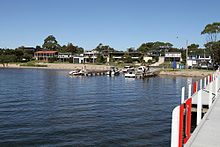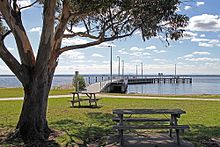Loch Sport
History
Before European settlement, the area was used for hunting and fishing, and the collection of water yams and other vegetable food. Some of their descendants still live in regional townships. Aboriginal middens are still present.
In the 19th century British settlers cleared the land and began farming. Sandy soils dominate the flat coastal heath scrubland, which is surrounded by brackish lakes on the north and Bass Strait on the south. Later in the 19th century Melburnians discovered the recreational potential of the lakes—fishing, swimming and boating—and by the beginning of the 20th century Loch Sport was accessible via a dirt track, with plots of land surveyed for the nascent township. With increasing use of private cars, more people bought property in the town which, in 1980, was one of the last Victorian towns to receive electricity.
Facilities
Loch Sport has a primary school, a bowls and tennis club, a caravan park, a marina, a pub, RSL club, boat club, service station with 24/7 fuel, post office and general store, hardware and garden centre, bakery, police station and supermarket, newly built in 2019. It also has a pharmacy, 2 real estate agents, a cafe, several massage therapists, and an art gallery. Golfers play at the course of the Loch Sport Golf Club on Spermwhale Head Road.
-
The boat launching ramps and houses on Victoria Parade
-
Looking north to the jetty and Lake Victoria
-
Looking west along the Lake Victoria shoreline towards the jetty
Environment
Next to the township lies the 2,390-hectare (5,900-acre) Lakes National Park which supports populations of kangaroos, echidnas, koalas, emus and many other birds, and a wide variety of wildflowers. It is also known for its large salt marsh mosquitos.
References
- ^ "2016 Census QuickStats Loch Sport". Australian Bureau of Statistics. Retrieved 6 October 2018.
- ^ "2011 Census QuickStats Loch Sport". Australian Bureau of Statistics. Retrieved 6 October 2018.
- ^ Golf Select, Loch Sport, retrieved 11 May 2009
- ^ Victoria's National Parks - Explorers Guide, p.206. (See Australia Guides). Parks Victoria. 1999.
External links



